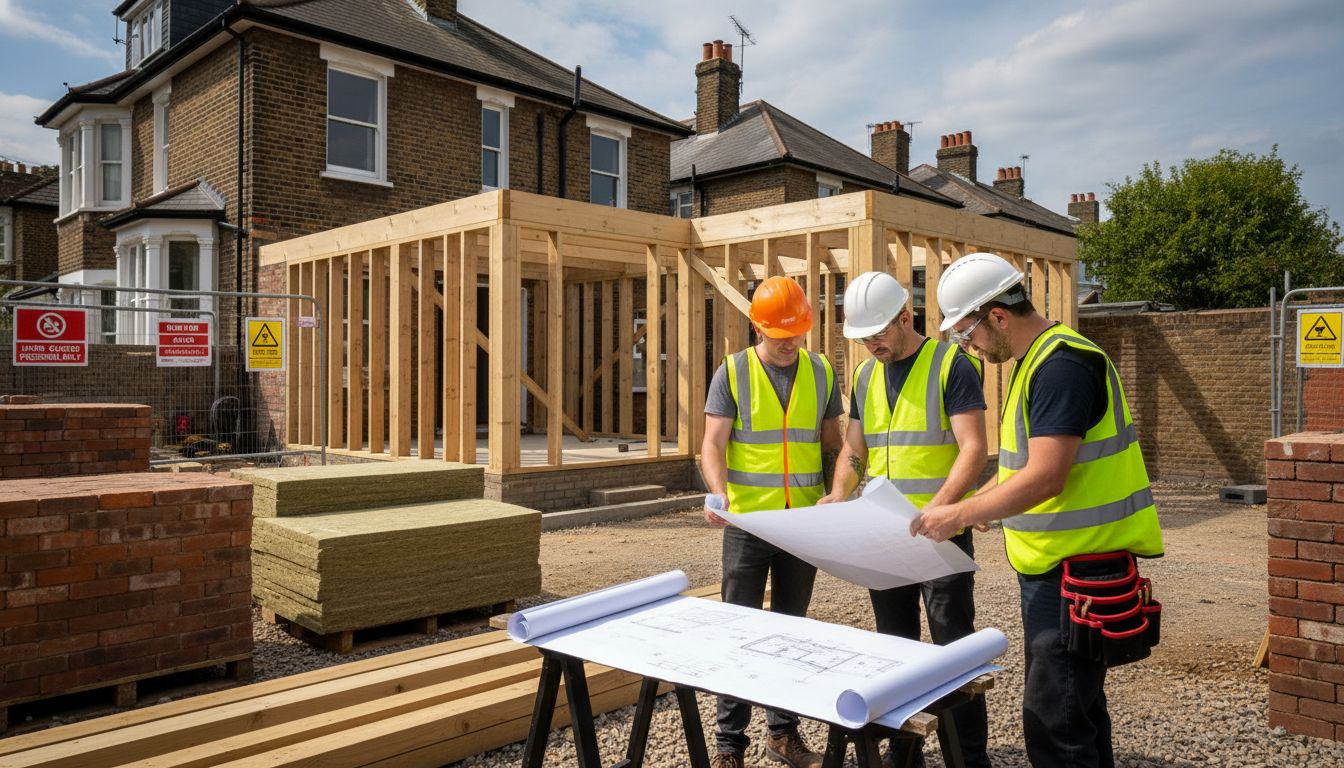Did you know that home extension costs in the UK can swing by more than £1,000 per square metre depending on your choices and location? For many London homeowners, building extra space means more comfort and higher property value, but it also brings plenty of financial questions. The right approach to estimating costs, picking extension types, and understanding local rules is the difference between success and unwelcome surprises, offering peace of mind before you commit to major changes.
Table of Contents
- Defining Cost Estimation For Home Extensions
- Types Of Home Extension Projects In London
- Key Factors Influencing Extension Costs
- Planning Permissions And Regulatory Fees
- Budgeting, Common Mistakes, And Cost-Saving Tips
Key Takeaways
| Point | Details |
|---|---|
| Comprehensive Cost Estimation | Accurate cost estimation involves understanding factors like materials, project complexity, and planning permissions to create a realistic budget. |
| Diverse Extension Types | Homeowners in London can choose from various extension types, each catering to different needs and property styles, impacting project complexity and costs. |
| Planning Permissions Essential | Navigating planning permissions and building regulations is crucial for legal compliance and successful project execution. |
| Strategic Budgeting | Developing a budget with contingency funds, phased spending, and early professional consultations can mitigate unexpected costs and enhance project value. |
Defining Cost Estimation for Home Extensions
Cost estimation for home extensions represents a critical financial planning process that helps homeowners understand potential investment requirements before embarking on construction projects. According to the UK government’s Cost Estimating Guidance, developing a robust cost estimate involves comprehensive analysis of multiple factors that influence overall project expenses. These factors go beyond simple construction calculations and encompass legal, planning, and structural considerations.
When approaching home extension cost estimation, homeowners must consider several key variables that impact total project expenses. These typically include material selection, project complexity, labour costs, site-specific challenges, and required planning permissions. As research from building control experts indicates, costs can vary dramatically based on specific construction methods and project scope. The understanding home extension cost calculation guide provides comprehensive insights into these nuanced considerations.
The cost estimation process typically involves multiple strategic stages. Homeowners should anticipate conducting initial site surveys, obtaining professional architectural assessments, researching material prices, and consulting with local building control authorities. Key steps include:
- Measuring exact extension dimensions
- Assessing structural requirements
- Calculating potential material expenses
- Understanding local planning regulations
- Budgeting for unexpected contingencies
Successful cost estimation requires thorough research, professional consultation, and a realistic approach to potential challenges.
 By understanding the comprehensive factors influencing home extension expenses, homeowners can develop accurate financial plans and make informed decisions about their property improvement projects.
By understanding the comprehensive factors influencing home extension expenses, homeowners can develop accurate financial plans and make informed decisions about their property improvement projects.
Types of Home Extension Projects in London
London homeowners have diverse options when considering property extensions, each offering unique benefits and addressing specific spatial needs. According to research from local building control authorities, home extensions in London typically fall into several primary categories, each tailored to different architectural styles and property requirements.
The most common types of home extension projects in London include:
Here is a summary of the main types of home extension projects in London and their characteristics:
| Extension Type | Key Features | Typical Use Case |
|---|---|---|
| Single-Storey | Ground floor Open-plan designs | Kitchen or living area expansion |
| Two-Storey | Multi-level Substantial extra space | Additional bedrooms and bathrooms |
| Rear Extension | Extends back Connects to garden | Enlarged dining or family rooms |
| Side Return Extension | Utilises side alley Improves layout | Widening kitchen/dining space |
| Wraparound Extension | Combines rear & side Maximises area | Significant transformation |
- Single-Storey Extensions: Ideal for ground floor renovations, typically extending kitchen, dining, or living spaces
- Two-Storey Extensions: Providing significant additional living and bedroom space across multiple levels
- Rear Extensions: Expanding property footprint at the back of the house, often maximizing garden interaction
- Side Return Extensions: Utilizing narrow side passages to create wider, more functional interior spaces
- Wraparound Extensions: Combining rear and side extensions for maximum spatial transformation
Research from St Albans local authorities highlights that extension types vary significantly based on property configuration and homeowner objectives.
The room extension ideas for London homes can provide inspiration for different architectural approaches. Project complexity and costs are influenced by factors such as structural requirements, material selection, and specific site constraints.
Each extension type presents unique considerations for London homeowners. Factors like conservation area regulations, permitted development rights, and structural implications must be carefully evaluated. Professional architectural consultation becomes crucial in determining the most suitable extension approach, ensuring compliance with local building regulations while achieving the desired spatial enhancement for your London property.
Key Factors Influencing Extension Costs
Home extension projects involve multiple complex variables that significantly impact overall financial investment. According to research from Redbridge local authorities, several critical factors determine the total cost of a home extension, making comprehensive planning essential for homeowners seeking to expand their living spaces.
The primary cost-influencing factors can be categorized into several key areas:
- Project Scale: Total square metre coverage directly affects budget requirements
- Material Quality: Selection of construction materials dramatically impacts overall expenses
- Site Complexity: Unique property characteristics and potential structural challenges
- Labour Costs: Skilled workforce pricing and project duration
- Additional Fixtures: Electrical, plumbing, and interior finishing expenses
Research from St Albans local authorities indicates that single-storey extensions typically range from £1,000 to £2,100 per square metre, highlighting the significant financial investment required. The understanding home extension cost factors can provide deeper insights into navigating these complex financial considerations. Regional variations, specific property constraints, and individual design preferences further nuance these baseline cost estimations.
Homeowners must approach extension projects with a holistic perspective, recognizing that seemingly minor design choices can substantially impact overall project expenses. Professional consultation becomes crucial in developing accurate budget projections, understanding potential hidden costs, and creating a financially sustainable approach to property expansion. Careful planning, thorough research, and realistic expectations are key to successfully managing home extension investments.
Planning Permissions and Regulatory Fees
Navigating the complex landscape of planning permissions and regulatory requirements is crucial for any home extension project. According to government guidelines, homeowners must understand the critical distinctions between planning permission and building regulations approval, as both play significant roles in ensuring legal compliance and construction quality.
Key aspects of planning permissions and regulatory requirements include:
- Planning Permission: Determines whether your proposed extension meets local urban planning standards
- Building Regulations Approval: Ensures the extension meets critical safety and structural standards
- Fees: Administrative costs associated with obtaining necessary approvals
- Documentation: Detailed architectural plans and site specifications
- Compliance Checks: Mandatory inspections during and after construction
According to UK government sources, building regulations approval is mandatory for most extension projects, regardless of size. Homeowners must submit comprehensive documentation demonstrating how their proposed project meets national construction standards. The planning permission requirements guide provides essential insights into navigating these complex regulatory landscapes.
Successful navigation of planning permissions requires careful preparation, professional guidance, and a thorough understanding of local regulatory frameworks. While the process might seem daunting, proactive engagement with local authorities and professional consultants can streamline the approval process, preventing potential legal complications and ensuring your home extension meets all necessary safety and structural standards.
Budgeting, Common Mistakes, and Cost-Saving Tips
Successful home extension projects demand strategic financial planning and proactive risk management. Research from local authorities emphasizes the importance of comprehensive budgeting and early professional consultation to navigate potential financial pitfalls and maximize project value.
Common budgeting mistakes and cost-saving strategies include:
- Contingency Funding: Allocate 10-15% extra for unexpected expenses
- Phased Budgeting: Break project into manageable financial stages
- Material Selection: Balance quality and cost-effectiveness
- Seasonal Planning: Schedule work during off-peak construction periods
- Energy Efficiency: Invest in long-term cost-saving design elements
According to St Albans local research, engaging architects and builders early significantly helps assess project feasibility and prevent costly miscalculations. The understanding what impacts extension cost provides crucial insights into strategic financial planning. Professional guidance can help identify potential savings without compromising structural integrity or design quality.
Homeowners should approach extension projects with a holistic financial perspective, recognizing that initial investments in quality design and professional consultation can prevent substantial unexpected expenses. Careful research, realistic budgeting, and maintaining flexibility throughout the project are key to achieving a successful home extension that delivers both aesthetic and financial value.
Take Control of Your Home Extension Costs with Expert Guidance
Understanding the complexities of cost estimation for home extensions can feel overwhelming. Key challenges like managing materials, navigating planning permissions, and anticipating unexpected expenses often leave homeowners anxious about going over budget or facing delays. You deserve clear, straightforward support that helps you confidently plan your dream extension with transparency and precision.
At Reltic Extend, we specialise in guiding London and Surrey homeowners through every stage of their bespoke home extension project. From detailed cost analysis through to professional project management, our 20 years of experience provide peace of mind and a focus on quality with a 10-year structural warranty. Explore our dedicated insights on Cost & Value of Home Extensions and learn how expert planning makes all the difference. Ready to move forward with confidence? Visit our Contact Us page today and discover how we can turn your vision into reality while keeping your budget on track.
Frequently Asked Questions
What factors influence the cost estimation of a home extension?
Cost estimation for a home extension is influenced by several factors including project scale, material quality, site complexity, labour costs, and additional fixtures such as electrical and plumbing features.
How can homeowners prepare for accurate cost estimation for their home extension?
Homeowners can prepare for accurate cost estimation by conducting site surveys, obtaining professional architectural assessments, researching material prices, and consulting with local building control authorities.
What is the difference between planning permission and building regulations approval for home extensions?
Planning permission determines if a proposed extension meets local urban planning standards, while building regulations approval ensures that the extension adheres to safety and structural standards. Both are essential for compliance.
What common budgeting mistakes should homeowners avoid when planning a home extension?
Common budgeting mistakes include not allocating contingency funds for unexpected expenses, failing to engage professionals early on, and neglecting to consider the long-term costs of material selection and energy efficiency.





